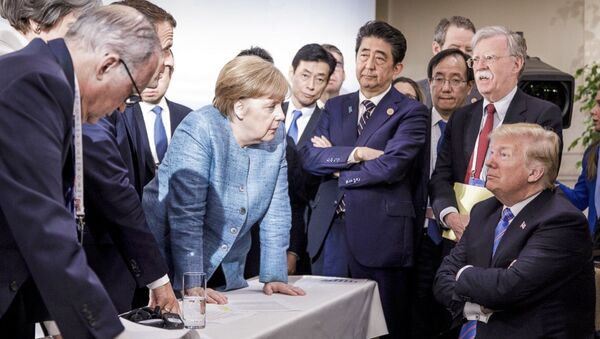When Trump campaigned for US president in the 2016 election, he pledged to "end endless wars," presenting himself as an isolationist and an outsider in stark contrast to the institutional legacy of Hillary Clinton, a former secretary of state, US senator and first lady who opposed him on the Democratic ticket that year.
Trump billed himself as a great negotiator, citing his career as a businessman of brokering deals with hard-headed clients and claiming it would give him a unique ability to smooth over conflicts with America’s adversaries.
“Deals are my art form,” Trump tweeted in 2014. “Other people paint beautifully or write poetry. I like making deals, preferably big deals. That's how I get my kicks.”
During his campaign, Trump promised to put “America First” and claimed that other nations, from China to Germany to Mexico, were taking advantage of the United States in various ways that hurt Americans, in many cases faulting Democrats like Clinton for having signed bad deals.
Europe and the UK
Trump’s relationships with European leaders were capricious, at times chumming around with them and then sharply criticizing them, as he did with French President Emmanuel Macron. His pushing of NATO members, in particular Germany, to substantially increase their defense spending helped spark talk of an independent European Army for the European Union, and at times he spoke openly of the alliance’s obsolescence. However, he also substantially expanded NATO’s eastern presence, sending troops from Germany into countries on the Russian border and building new installations in Poland.
Meanwhile, during Trump’s tenure, the United Kingdom, the US’ closest ally in Europe, went through the tortuous debates about if and how to depart from the EU. On the one hand, Trump encouraged London to “walk away” if Brussels wouldn’t give them a fair post-Brexit deal, but on the other, dismissed any notion of the UK signing a separate free trade agreement with the US afterward. Still, the two countries’ “special relationship” has endured.
Iran and the Middle East
When it came to the Middle East, the center of US military activity for the last 30 years, Trump turned US policies on their heads, in perhaps no place more so than Iran.
In 2018, Trump unilaterally withdrew the US from the Joint Comprehensive Plan of Action (JCPOA), a 2015 deal signed by the US, Iran, France, Germany, the UK, the EU, Russia and China, that saw Iran give up plans for building a nuclear weapon in exchange for the lowering of decades’ worth of crippling economic sanctions.
Trump claimed Iran had secretly been violating the nuclear agreement, but nuclear inspectors could find no evidence of his claims, and the incongruence created a rift between the US and many of its allies, who continued to adhere to a deal they did not believe had been violated and from which they benefited economically.
War tensions grew even further after Trump designated Iran’s Islamic Revolutionary Guard Corps (IRGC) a terrorist organization, again lacking any concrete proof, and in January of 2020 assassinated Maj. Gen. Qasem Soleimani, the commander of the IRGC’s elite Quds Force, in a brazen drone attack in Iraq. Days after Soleimani’s killing, Iran launched a revenge attack with dozens of ballistic missiles against Ayn al-Asad and Erbil air bases in Iraq, injuring more than a hundred US soldiers stationed in the country.
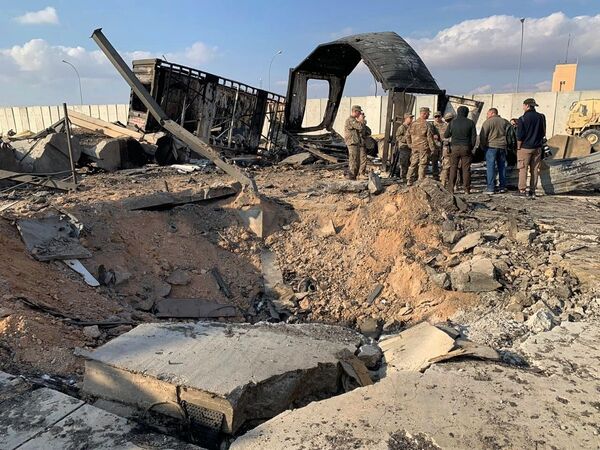
In Syria, Trump’s presidency oversaw the killing of Daesh leader Abu Bakr al-Baghdadi and the conclusion of the international war against Daesh, but despite his pledges to bring troops home, the US has remained mired in the Syrian Civil War. In Iraq, the assassination of Soleimani, done without prior permission for a strike from Baghdad, prompted the Iraqi parliament to ask US troops to leave the country - a request Trump threw back in their faces, evoking memories of the 2003-2011 US occupation.
Israel
Under Trump, the US’ close relationship with Israel only strengthened, with Trump recognizing Israel’s claiming of Jerusalem as its capital as well as its annexation of Syria’s Golan Heights. His administration was also instrumental in winning Israel unprecedented diplomatic recognition across the Arab world.
The so-called “deal of the century” saw Israel trade plans to extend its sovereignty over parts of the West Bank in exchange for the normalization of diplomatic relations with the United Arab Emirates, which were quickly followed by Bahrain, Sudan and Morocco. However, the deal also purported to have solved the conflict between Israel and Palestine with a series of infrastructure initiatives, drawing wide criticism for failing to address any of the underlying issues of the dispute.
Afghanistan
In Afghanistan, Trump oversaw a peace deal with the Taliban militant group, which the US invaded the Central Asian country 19 years ago to overthrow and has been locked in a counterinsurgency war against ever since. However, as he prepares to leave office, a separate deal between the Taliban and the US-backed Kabul government has yet to come to fruition.
“It seems that US policy-making circles are reaching a consensus that the war cannot be decisively won through military means, and there has to be a political solution,” says Umer Karim, a visiting fellow at the Royal United Services Institute, a London-based think tank. Karim points out that incoming US President-elect Joe Biden has long been against deepening the war in Afghanistan, having opposed the 2009 troop surge implemented while he was vice president, making it unlikely his policy will deviate from the path laid out by the Trump administration.
Democratic People’s Republic of Korea
The US relationship with the DPRK, the socialist nation on the northern half of the Korean Peninsula, was perhaps the most dynamic of any during Trump’s administration. It began with Trump threatening to bomb North Korea in retaliation for its thermonuclear weapons test and ballistic missile tests, shifted into a policy of negotiation and reconciliation that yielded heretofore unseen results, and has ended in an increasingly tense detente after negotiations stalled.
“I think both parties came to the Singapore and Vietnam meetings knowing full well of what they wanted, but at the same time knowing the limitations of what they can actually achieve and agree on,” Dr. Victor Teo, The Cold War Project fellow at CRASSH, University of Cambridge, says about the June 2018 and February 2019 summits between Trump and North Korean leader Kim Jong Un, a man half his age with whom he traded no shortage of barbs and insults before quickly developing a rapport.
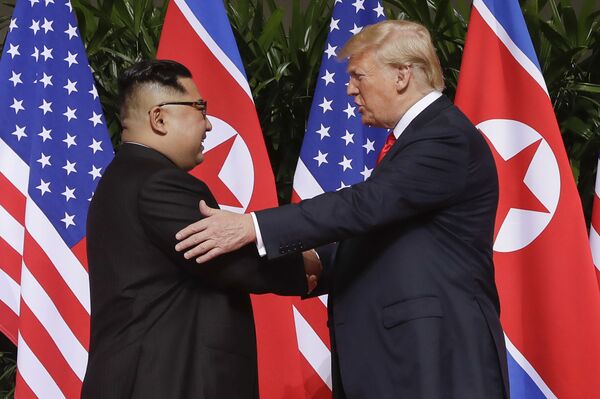
“The Trump administration achieved its primary goal of getting the North Koreans to stop threatening the United States with purported ICBM [intercontinental ballistic missile] development and nuclear tests. This actually boosted President Trump’s domestic political standing, and arguably is an important achievement in US foreign policy, even though many of Trump’s opponents will deny that this is the case. However, more importantly, President Trump removed an important ‘chess piece’ from China’s geostrategic arsenal by ensuring that DPRK threat is ‘neutralized’ as he embarks on a comprehensive effort to confront the Chinese.”
Russian Federation
Trump's relationship with Russia has followed him ever since he became president. Democrats blamed Trump’s unexpected election victory on supposed interference in the 2016 election by Russia, launching a two-year legal probe that ended without conclusive evidence of their claims. Contrary to their baseless claims of Trump being under the control of Russian President Vladimir Putin and that he was being “soft” on Russia, under Trump US-Russia relations only continued to worsen.
In December 2017, the White House initiated a new shift in US political and military strategy toward “great power competition” with Russia and China, saying the “revisionist” powers aimed to upend the global US-led world order, which constituted a greater threat to the US than international terrorist groups. Under Trump, the US has introduced more sanctions against Russia than any previous president, including the Countering America's Adversaries Through Sanctions Act (CAATSA), which punishes countries that buy advanced defense technology from Russian companies, or from Iran or North Korea.

Trump also tried to drive a wedge between Russia and European countries such as Germany by pressuring Berlin to buy US liquefied natural gas and threatening to sanction Germany over the nearly-complete Nord Stream II gas pipeline, which will bring Russian natural gas into central Europe via Germany’s Baltic Sea coast.
People’s Republic of China
Where Trump’s approach to North Korea was topsy-turvy, his policy toward China was one of steadily increasing conflict.
His administration began with accusations of China taking advantage of US trade rules, which led to his imposition of huge tariffs on imports from China in a bid to reverse the longstanding trade deficit, but instead prompted equal tariffs from Beijing. By February of 2020, Phase 1 of a trade deal had been agreed upon that promised to end the trade war, but the onset of the COVID-19 pandemic has severely frustrated adherence to the deal’s goals.
Adjoining the trade war were parallel claims about Chinese tech giants such as Huawei being manipulated by the Communist Party of China to spy on the users of their gadgets, leading to the blacklisting of dozens of Chinese firms despite pleadings by corporate leaders and communist officials that such “backdoors” in the technology did not exist.
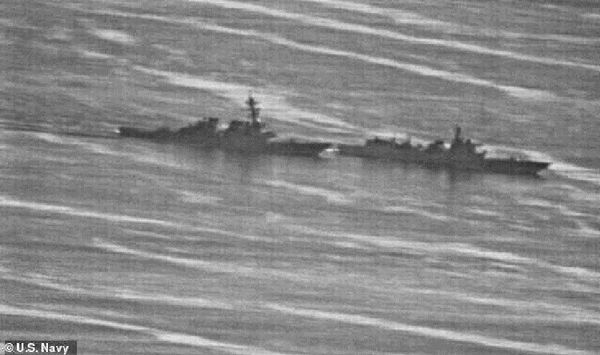
Like Russia, the White House identified China as a “revisionist power” it claimed aims to upend the US-led global order, and the US reoriented its foreign policy under Trump to “confront” China in a new cold war. From Taiwan to Hong Kong to the South China Sea, the Trump administration has moved to bolster anti-Beijing forces and undermine Chinese activities in the name of defending the “international rules-based order.” In China’s autonomous city of Hong Kong and autonomous region of Xinjiang, the US has also invoked claims of vast human rights violations and brought sanctions against Beijing in response.
In 2020, US hostility to China entered a new stage with the COVID-19 pandemic. A highly infectious viral upper respiratory disease related to the common cold that broke out in the Chinese city of Wuhan in the final days of 2019 was nearly contained by Chinese authorities, but managed to spread to other nations - first to Iran, then Italy, Western Europe and the United States. As the pandemic grew out of control, millions became infected, and hundreds of thousands of Americans have died. The concurrent economic shutdowns implemented in a bid to stem the spread of the disease threw the US economy into an unprecedented crisis.
Trump has attempted to claim the pandemic is China’s fault, suggesting Beijing purposefully allowed the US population to become infected in order to undermine the success of his administration, and he claimed it manipulated the World Health Organization and its own statistics in order to conceal the dangers of COVID-19.
Venezuela
Late in Barack Obama’s administration, he declared Venezuela a national security threat to the US. However, under Trump the US’ attempt to undermine the Bolivarian Revolution became far more acute. Even before the US announced its support for self-proclaimed interim president Juan Guaido in January 2019, Trump was moving to undermine Venezuelan President Nicolas Maduro by bringing sanctions against his government that made foreign trade increasingly difficult.
Trump’s support for Guaido and the appointing of Elliott Abrams as special envoy to Venezuela, a man who narrowly escaped prison time for his role in circumventing US law to funnel weapons to right-wing guerrillas in Central America in the 1980s, brought the South American nation into an unprecedented crisis. Punishing sanctions killed tens of thousands of people and brought the country’s economy to a halt, all in an attempt to force Venezuelans to overthrow Maduro and the socialist Chavista movement.
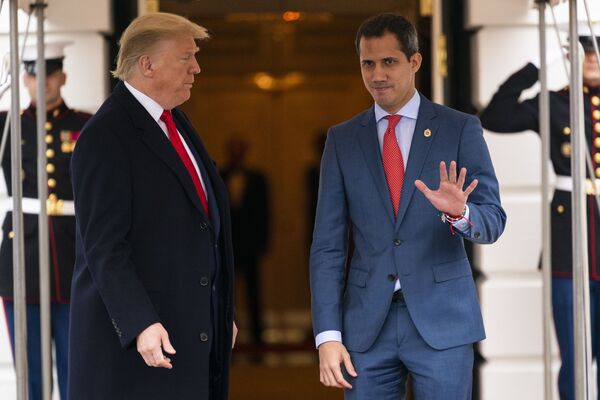
As Trump’s presidency draws to a close, even other elements of the Venezuelan opposition have abandoned Guaido, and Maduro’s popularity has only widened, with December 6 parliamentary elections returning the largest victory for his United Socialist Party of Venezuela (PSUV) ever seen.
Mexico and Canada
Trump ran on a promise to renegotiate the North American Free Trade Agreement (NAFTA), which, similar to trade deals with China, he believed gave US workers an unfair deal. By January 2020, the three nations party to that deal had hammered out a new US-Mexico-Canada Agreement (USMCA) that gave the US increased access to Canada’s dairy market and imposed quotas on automobile production in Canada and Mexico while lifting US tariffs on aluminum and steel from both countries.
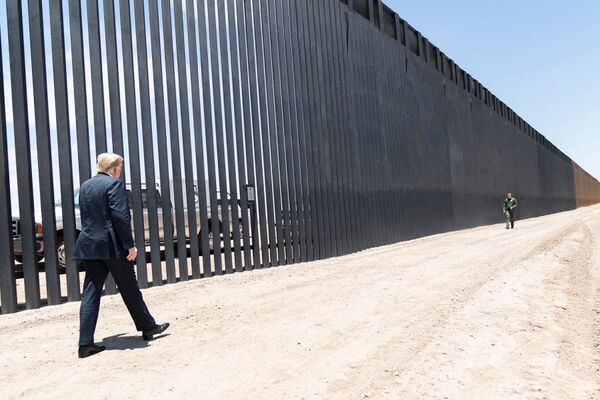
Trump also ran on a policy of ending illegal immigration from Mexico and Central America into the US, pledging to build a border wall that would end all unregulated border crossings. He blamed Mexico City for failing to deal with migrant caravans traveling from Central America and strong-armed the country to cooperate with his immigration clampdown, including with threats to totally close the border. In the end, Mexico deployed tens of thousands of troops to the US border as well as to its border with Guatemala.
A previous version of this story incorrectly stated Qatar had normalized relations with Israel.

